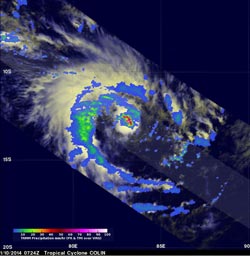NASA Adds Up Tropical Cyclone Colin's Rainfall Rates

NASA's TRMM satellite captured an image of rainfall occurring in Tropical Cyclone Colin on Jan. 13 at 0753 UTC. The bulk of Colin's rainfall was west and south of the center. <br>Image Credit: NASA/JAXA/SSAI, Hal Pierce<br>
The Tropical Rainfall Measuring Mission or TRMM satellite is managed by NASA and the Japan Aerospace Exploration Agency. TRMMM captured an image of rainfall rates occurring in Colin on Jan. 13 at 0753 UTC/2:53 a.m. EST.
TRMM Precipitation Radar showed that the bulk of Colin's rainfall was west and south of the center and there were some isolated areas where rain was falling at a rate of up to 2 inches/50 mm per hour.
Tropical Cyclone Colin is the eighth tropical cyclone in the Southern Indian Ocean cyclone season this year. It also has a separate designation from La Reunion Island, where it is known as “06/2013/2014.”
At 0900 UTC/4 a.m. EST on Jan. 13, Colin's maximum sustained winds were near 80 knots/148.2 kph/92.0 mph. Colin was located about 938 nautical miles/1,079 miles/1,737 km south of Diego Garcia, near 23.1 south and 75.0 east. Colin is moving to the south-southeast at 14 knots/16.1 mph/25.9 kph and over cooler sea surface temperatures that will cause it to weaken.
In addition to cooler sea surface temperatures, vertical wind shear is increasing as Colin tracks further south-southeast. Colin is expected to become extra-tropical in the next couple of days.
Text credit: Rob Gutro
NASA's Goddard Space Flight Center
Media Contact
All latest news from the category: Earth Sciences
Earth Sciences (also referred to as Geosciences), which deals with basic issues surrounding our planet, plays a vital role in the area of energy and raw materials supply.
Earth Sciences comprises subjects such as geology, geography, geological informatics, paleontology, mineralogy, petrography, crystallography, geophysics, geodesy, glaciology, cartography, photogrammetry, meteorology and seismology, early-warning systems, earthquake research and polar research.
Newest articles

Recovering phosphorus from sewage sludge ash
Chemical and heat treatment of sewage sludge can recover phosphorus in a process that could help address the problem of diminishing supplies of phosphorus ores. Valuable supplies of phosphorus could…

Efficient, sustainable and cost-effective hybrid energy storage system for modern power grids
EU project HyFlow: Over three years of research, the consortium of the EU project HyFlow has successfully developed a highly efficient, sustainable, and cost-effective hybrid energy storage system (HESS) that…

After 25 years, researchers uncover genetic cause of rare neurological disease
Some families call it a trial of faith. Others just call it a curse. The progressive neurological disease known as spinocerebellar ataxia 4 (SCA4) is a rare condition, but its…





















